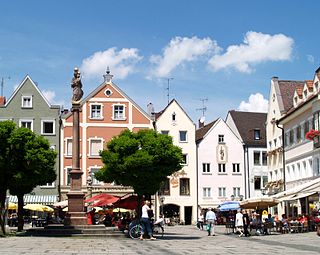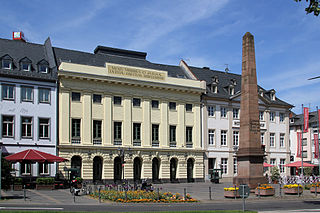Ulrich Willerding is a professor emeritus of botany at the Göttingen University, Germany. He is also an instructor at a local high school. Willerding is one of the leading European palaeo-ethnobotanists. He has specialized in Medieval Europe but also done work on other times. One of his special interests is weeds. He has worked on bibliographies of European paleoethnobotany. Although a biologist by training, he has worked extensively with archaeologists.

Nettetal is a municipality in the district of Viersen, North Rhine-Westphalia, Germany. It is situated in the Lower Rhine region.

Geislingen is a town in the Zollernalbkreis district of Baden-Württemberg, Germany. It is situated 4 km northwest of Balingen. The population stands at roughly 6,000. Geislingen includes three smaller towns, Geislingen, Erlaheim, and Binsdorf, all of them growing about 1% per year. The area has been continuously settled since the Stone Age. The first written documentation of Binsdorf came in 834, Geislingen was officially mentioned in 1188. The local economy mixes agriculture with services and small-scale industry. Many residents work in industrial areas south of Stuttgart or in nearby Balingen.

Koblenz Hauptbahnhof is a railway station in the city of Koblenz in the German state of Rhineland-Palatinate. It is the focal point of rail transport in the Rhine-Moselle-Lahn area. It is a through station in southern Koblenz built below Fort Großfürst Konstantin and opened in 1902 in the Neustadt, which was built after the demolition of the city walls in 1890. The station replaced two former stations on the Left Rhine railway, which were only 900 m apart, and the former Moselle line station. Koblenz-Stadtmitte station opened in April 2011 in the old centre of Koblenz. Koblenz Hauptbahnhof is on the West Rhine Railway and connects to the Moselle line, the East Rhine Railway and to the Lahntal railway. It is used daily by about 40,000 travelers and visitors. In the station forecourt are a bus station and a pavilion.

The Twelve Articles were part of the peasants' demands of the Swabian League during the German Peasants' War of 1525. They are considered the first draft of human rights and civil liberties in continental Europe after the Roman Empire. The gatherings in the process of drafting them are considered to be the first constituent assembly on German soil.

August Ritter von Clemm was a German businessman and politician.

The Kaldenkirchen Sequoia Farm is a German arboretum that has been used as a biological institute for many years. Part of the protected area in the city of Nettetal, it is situated in the "Kaldenkirchen Grenzwald". Nettetal lies in the Lower Rhine region of Germany.

Weilheim in Oberbayern is a town in Germany, the capital of the district Weilheim-Schongau in the south of Bavaria. Weilheim has an old city-wall, historic houses and a museum.
Heinz Schilling is a German historian.

Koblenz-Ehrenbreitstein station is the only station on the right (eastern) bank in the city of Koblenz in the German state of Rhineland-Palatinate. It is on the East Rhine railway at the foot of the Ehrenbreitstein hill in the Ehrenbreitstein district, next to the Rhine.
Clemens-Brentano-Preis of the city of Heidelberg is a literary prize of Germany. It was established in 1993, and named after the German poet Clemens Brentano (1778–1842). The prize money is €10,000.
The following is a timeline of the history of Koblenz, Germany.

The Old Castle was a former Elector-owned, substantial water castle in the German city of Koblenz, incepted in the 13th century. It is today reduced to the later Burghaus ; which houses the city archives. It sits on tall foundations and has a tall, black slate roof with further floors in the attic and two small cupolas. The lowland castle abutted the remaining building in the old town quarter. The castle house stands tall, next to the Moselle's right-bank towpath downstream of the strategic Baldwin Bridge built in 1342. The bridge, much-repaired, remains intact.
Wilhelm Jannasch was a German Protestant theologian and clergyman.

The Griffin cannon, also called Vogel Greif,, is one of the largest cannons from the 16th century. Since 1984, it has been in display in the Ehrenbreitstein Fortress in Koblenz. The possession of the cannon moved several times between Germany and France and became a symbol of the Franco-German reconciliation.

Klaus Mlynek is a German historian and scientific archivist. The long-term director of the Stadtarchiv Hannover is one of the editors and authors of the Stadtlexikon Hannover, an encyclopedia of Hanover.
Waldemar R. Röhrbein was a German historian. He worked as a museum director in Lower Saxony, his last post being from 1976 to 1997 at the Historisches Museum Hannover, and was president of the Niedersächsischer Heimatbund. He contributed to encyclopedias about Hanover's history and culture.
Herbert Schwarzwälder was a German historian. With his decades of work and his extensive publications, he has had a major influence on the research and communication of the History of the city of Bremen.

The Theater Koblenz is a multi-arts theatre with its own ensembles for drama, music theatre, puppetry and ballet located in Koblenz, Germany. It has about 190 permanent employees from 22 nations and offers 500 seats in a theatre building from the 18th century not far from the Electoral Palace. The manager until the end of the 2024/2025 season is Markus Dietze. Venues include the Theater am Deinhardplatz, rehearsal stages 2 and 4 as well as the Festung Ehrenbreitstein for the summer performances. In addition, the theatre participated in the Koblenz Fortress Plays for several years. In the 2009/2010 season, it was renamed from Theater der Stadt Koblenz to its current name.

Koblenz Charterhouse was a Carthusian monastery, or charterhouse, in Koblenz, Rhineland-Palatinate, Germany. It stood on the Beatusberg, a hill that forms the north-easterly tip of the Hunsrück overlooking the city. The site was first occupied by a Benedictine monastery, the Kloster St. Beatusberg, which was closed in 1315, when the monks were replaced by a community of Augustinian Canons until the Carthusians took over the site in 1331.


















